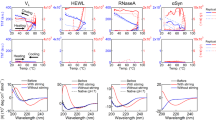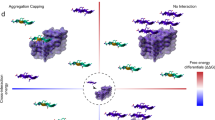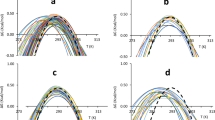Abstract
Hydrogen exchange experiments monitored by NMR and mass spectrometry reveal that the amyloidogenic D67H mutation in human lysozyme significantly reduces the stability of the β-domain and the adjacent C-helix in the native structure. In addition, mass spectrometric data reveal that transient unfolding of these regions occurs with a high degree of cooperativity. This behavior results in the occasional population of a partially structured intermediate in which the three α-helices that form the core of the α-domain still have native-like structure, whereas the β-domain and C-helix are simultaneously substantially unfolded. This finding suggests that the extensive intermolecular interactions that will be possible in such a species are likely to initiate the aggregation events that ultimately lead to the formation of the well-defined fibrillar structures observed in the tissues of patients carrying this mutation in the lysozyme gene.
This is a preview of subscription content, access via your institution
Access options
Subscribe to this journal
Receive 12 print issues and online access
$189.00 per year
only $15.75 per issue
Buy this article
- Purchase on Springer Link
- Instant access to full article PDF
Prices may be subject to local taxes which are calculated during checkout






Similar content being viewed by others
Accession codes
References
Koo, E.H., Lansbury, P.T. & Kelly, J.W. Amyloid diseases: abnormal protein aggregation in neurodegeneration. Proc. Natl. Acad. Sci. USA 96, 9989–9990 (1999).
Perutz, M.F. Glutamine repeats and neurodegenerative diseases: molecular aspects. Trends Biochem. Sci. 24, 58–63 (1999).
Tan, S.Y. & Pepys, M.B. Amyloidosis. Histopathology 25, 403–414 (1994).
Pepys, M.B. et al. Human lysozyme gene mutations cause hereditary systemic amyloidosis. Nature 362, 553–557 (1993).
Booth, D.R. et al. Instability, unfolding and aggregation of human lysozyme variants underlying amyloid fibrillogenesis. Nature 385, 787–793 (1997).
Morozova-Roche, L.A. et al. Amyloid fibril formation and seeding by wild type human lysozyme and its disease-related mutational variants. J. Struct. Biol. 130, 339–351 (2000).
Goda, S. et al. Amyloid protofilament formation of hen egg lysozyme in highly concentrated ethanol solution. Protein Sci. 9, 369–375 (2000).
Krebs, M.R.H. et al. Formation and seeding of amyloid fibrils from wild-type hen lysozyme and a peptide fragment from the β-domain. J. Mol. Biol. 300, 541–548 (2000).
Kelly, J.W. The alternative conformations of amyloidogenic proteins and their multi-step assembly pathways. Curr. Opin. Struct. Biol. 8, 101–106 (1998).
Englander, S.W. Protein folding intermediates and pathways studied by hydrogen exchange. Annu. Rev. Biophys. Biomol. Struct. 29, 213–238 (2000).
Roder, H., Elove, G.A. & Englander, S.W. Structural characterization of folding intermediates in cytochrome c by H exchange labeling and proton NMR. Nature 335, 700–704 (1988).
Raschke, T.M. & Marqusee, S. Hydrogen exchange studies of protein structure. Curr. Opin. Biotechnol. 9, 80–86 (1998).
Bai, Y., Milne, J.S., Mayne, L. & Englander, S.W. Primary structure effects on peptide group hydrogen exchange. Proteins Struct. Funct. Genet. 17, 75–86 (1993).
Hooke, S. Cooperative elements in protein folding monitored by electrospray ionization mass spectrometry. J. Am. Chem. Soc. 117, 7548–7549 (1995).
Miranker, A., Kruppa, G.H., Robinson, C.V., Aplin, R.T. & Dobson, C.M. Isotopic-labeling strategy for the assignment of protein fragments generated for mass spectrometry. J. Am. Chem. Soc. 118, 7402–7403 (1996).
Miranker, A., Robinson, C.V., Radford, S.E., Aplin, R.T. & Dobson, C.M. Detection of transient protein folding populations by mass spectrometry. Science 262, 896–899 (1993).
Wang, L., Lane, L.C. & Smith, D.L. Detecting structural changes in viral capsids by hydrogen exchange and mass spectrometry. Protein Sci. 10, 1234–1232 (2001).
Engen, J.R., Smithgall, W.H., Gmeiner, T.E. & Smith, D.L. Identification and localization of slow, natural, cooperative unfolding in the hematopoietic cell kinase SH3 domain by amide hydrogen exchange and mass spectrometry. Biochemistry 36, 14384–14391 (1997).
Zhang, Z. & Smith, D.L. Determination of amide hydrogen exchange by mass spectrometry: a new tool for protein structure elucidation. Protein Sci. 2, 522–531 (1993).
Tito, P. & Robinson, C.V. Hydrogen exchange of proteins in partially folded states: a quadrupole time-of-flight approach. Methods Enzymol. In the press (2002).
Redfield, C. & Dobson, C.M. 1H NMR studies of human lysozyme: spectral assignment and comparison with hen lysozyme. Biochemistry 29, 7201–7214 (1990).
Dobson, C.M., Evans, P.A. & Radford, S.E. Understanding how proteins fold: the lysozyme story so far. Trends Biochem. Sci. 19, 31–37 (1994).
Hooke, S.D., Radford, S.E. & Dobson, C.M. Refolding of human lysozyme — a comparison with the structurally homologous hen lysozyme. Biochemistry 33, 5867–5876 (1994).
Dobson, C.M. The structural basis of protein folding and its links with human disease. Phil. Trans. R. Soc. Lond. A/B 356, 133–145 (2001).
Chiti, F. et al. Designing conditions for in vitro formation of amyloid protofilaments and fibrils. Proc. Natl. Acad. Sci. USA 96, 3590–3594 (1999).
Guijarro, J.I.I., Sunde, M., Jones, J.A., Campbell, I.D. & Dobson, C.M. Amyloid fibril formation by an SH3 domain. Proc. Natl. Acad. Sci. USA 95, 4224–4228. (1998).
Chamberlain, A. et al. Ultrastructural organization of amyloid fibrils by atomic force microscopy. Biophys. J. 79, 3282–3293 (2000).
Dobson, C.M., Sali, A. & Karplus, M. Protein folding: A perspective from theory and experiment. Angew. Chem. Int. Ed. Engl. 37, 868–893 (1998).
Canet, D. et al. Mechanistic studies of the folding of human lysozyme and the origin of amyloidogenic behavior in its disease related variants. Biochemistry 38, 6419–6427 (1999).
Spencer, A. et al. Expression, purification and characterisation of the recombinant calcium-binding equine lysozyme secreted by the filamentous fungus Aspergillus niger. Protein Exp. Purif. 16, 171–180 (1999).
Woodruff, N. PhD. Thesis. Investigation of protein structure and folding by NMR spectroscopy. (University of Oxford; 1998).
Ohkubo, T., Taniyama, Y. & Kikuchi, N. 1H and 15NMR study of human lysozyme. J. Biochem. 110, 1022–1029 (1991).
Wilm, M. & Mann, M. Analytical properties of the nanoelectrospray ion source. Anal. Chem. 68, 1–8 (1996).
Chung, E.W. et al. Hydrogen exchange properties of proteins in native and denatured states monitored by mass spectrometry and NMR. Protein Sci. 6, 1316–1324 (1997).
Koradi, R., M, B. & Wuthrich, K. MOLMOL: A program for the display and analysis of macromolecular structures. J. Mol. Graph. 14, 51–55 (1996).
Acknowledgements
D.C. was supported by a fellowship from the European Community, C.R. is supported by a BBSRC Advanced Research Fellowship, and C.V.R. and M.S. hold Royal Society University Research Fellowships. This work is in part a contribution from the Oxford Centre for Molecular Sciences, which is supported by EPSRC, BBSRC and MRC. The research of C.M.D. is also supported in part by a programme grant from the Wellcome Trust.
Author information
Authors and Affiliations
Corresponding authors
Ethics declarations
Competing interests
The authors declare no competing financial interests.
Rights and permissions
About this article
Cite this article
Canet, D., Last, A., Tito, P. et al. Local cooperativity in the unfolding of an amyloidogenic variant of human lysozyme. Nat Struct Mol Biol 9, 308–315 (2002). https://doi.org/10.1038/nsb768
Received:
Accepted:
Published:
Issue Date:
DOI: https://doi.org/10.1038/nsb768
This article is cited by
-
Diabetes-Associated Mutations in Proinsulin Provide a “Molecular Rheostat” of Nascent Foldability
Current Diabetes Reports (2022)
-
Reflections on professor Sir Christopher M. Dobson (1949–2019)
Biophysical Reviews (2020)
-
Application of Lysine-specific Labeling to Detect Transient Interactions Present During Human Lysozyme Amyloid Fibril Formation
Scientific Reports (2017)
-
The Folding process of Human Profilin-1, a novel protein associated with familial amyotrophic lateral sclerosis
Scientific Reports (2015)
-
Lysozyme stability and amyloid fibrillization dependence on Hofmeister anions in acidic pH
JBIC Journal of Biological Inorganic Chemistry (2015)



